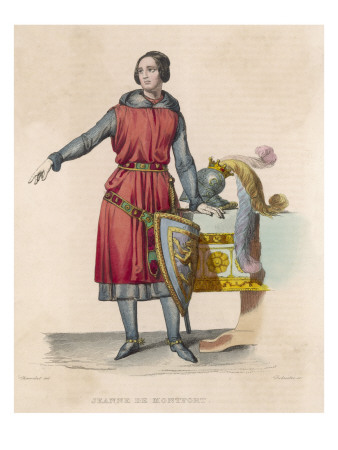Treasures in the Paper Pile,Pt 2:Joanna of Flanders, also known as Jeanne la Flamme
In recent weeks I’ve been working my way through some of the paper stashes that have accumulated in the corners of my office in anticipation of the arrival of a new desk which will give me room for two computer screens. In the course of sorting, I’ve run across a couple of women warriors I had forgotten about.
Previously I introduced you to Jeanne the Hatchet. Next up, Joanna of Flanders, who fought for first her husband’s and later her son’s claims in the War of the Breton Succession. The war was a sideshow in the Hundred Years War between the French Valois dynasty and the English Lancastrian dynasty over the control of France, which had begun in 1337.* In 1341, England and France were in a period of fragile truce, and the War of Breton Succession became a proxy for the larger conflict.
The conflict began in 1341, when the Duke of Brittany died without a direct heir. There were two rival claimants for the lands and title: his half-brother John of Monfort (aka the husband of Joanna of Flanders), whose claims were supported by the English, and Charles of Blois (aka the husband of Joan of Penthièvre, niece of the late duke), whose claims were supported by the French king, Philip VI (aka Charles of Blois’s nephew). **
After obtaining a safe conduct from Philip, John of Monfort traveled to Paris to make his case. (You can see that this won’t end well, right?) Philip, who was not an impartial observer, did not honor the safe conduct. He imprisoned John, and declared Charles of Blois the Duke of Brittany.
Joanna continued to battle in his absence. In the process, she earned the nickname Jeanne la Flamme, or fiery Joan. Some of my sources claim it was because of her determination. Others claim that she rode out of the besieged town of Hennebont with a troop of her men and set the enemy camp on fire. When it became clear that she was losing ground against de Blois’s troops, she sailed to England, where she succeeded in gaining help from Edward III.
In 1344, John Montfort escaped or was released from prison, depending on who you read, and returned to the fight. After his death in 1345, Jeanne continued to fight for her son’s claim to the duchy. (There is reason to believe that Jeanne of Penthièvre also led troops in the war. In fact, it is sometimes called the War of the Two Jeannes.) The war finally ended in 1364, when Charles de Blois was killed in the battle of Auray and Jeanne of Penthièvre was forced to sign away the title of Duchess of Brittany which she had held for almost twenty years and content herself with being the countess of Penthièvre. The Montforts remained in control of the duchy of Brittany until 1547, when Brittany was unified with France.
Jeanne of Penthièvre actually enjoyed a happier ending to the story than her rival. By some accounts, Joanna of Flanders was declared to be mentally ill and confined to a castle in England by order of King Edward. A favorite way over the centuries to dispose of a troublesome woman.
*A war that ended with the help of another woman warrior, Joan of Arc. You might have heard of her.
**At first glance it would seem to a modern history buff that John of Monfort had the stronger claim, but succession in the medieval period was not a clear-cut a matter of primogenitor. The dead Duke had disliked John of Monfort and the other children of his father’s second marriage and named his niece, Joan of Penthièvre, as his successor. Then—because why make things simple—the Duke reconciled with John the year before he died and made a will naming John of Montfort his heir. This is the kind of thing that makes for great mystery novels and difficult transfers of power.





